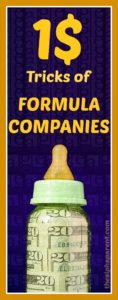
Infant formulas were originally designed to be a medical nutritional tool for babies who are unable to breastfeed due to unfortunate circumstances such as maternal death or illness. Nowadays the formula industry accounts for US$20.2 billion (data for 2010). It doesn’t take Einstein to figure out that formula is now being used by more than the 2% of women who physically can’t breastfeed. What went wrong? Formula companies got greedy and laws didn’t keep up, that’s what. The greedier the company, the more strategic and underhanded their marketing becomes. This article exposes 15 tricks of the most popular formula companies, illustrating how greed is more powerful than concern for infant welfare.
Trick #1: Get your logo everywhere
FACT: Exposure to formula promotion increases significantly breastfeeding cessation in the first 2 weeks. Also, among women with uncertain goals or breastfeeding goals of 12 weeks or less, exposure to formula promotion results in exclusive, full, and overall breastfeeding duration being shortened (Howard C et al. Obstetrics and Gynaecology Vol 5, No 2, Feb 2000 p296-303).
This is bad news for babies, but great news for formula companies. The less women who breastfeed – the more formula is purchased. This means lots of wonga for the shareholders. To put this scenario in context, check out the following stats:
The advertising spend for formula companies in 2006/07 was £7,626,847, an increase of 36.6% on the previous year.
The UK Government budget for promoting breastfeeding was £729,011 in 2006/07, a decrease on the 2004/05 figure of £747,000.
(Figures published by Save the Children).
The key to successful product marketing is to get as much exposure as possible, and the formula companies have got this down to a tee. They’ve been churning out hard sell marketing for decades. Here’s a Cow & Gate advertisement published widely in 1940s and 1950s UK:
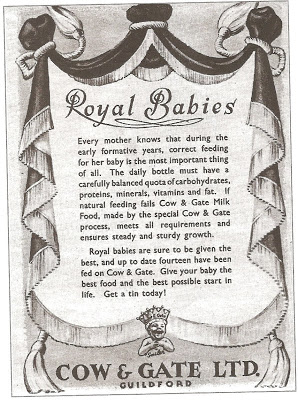
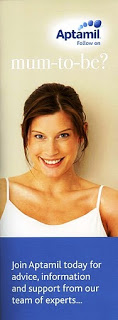
“The best possible start in life”? Looks like formula companies’ lack of accuracy is nothing new. Nowadays they just find more covert and underhanded ways to mislead parents. They advertise in parenting magazines and, more recently, fashion and celebrity magazines. Here is an advertisement from Aptamil (right) featured in Pregnancy Magazine April 2008. It is a stitched insert so that the magazine naturally falls open at that page. I’ll talk more about advertising to pregnant women bellow.
With so many formula companies paying vast amounts of money to parenting magazines, is it any wonder the deputy editor of Mother and Baby magazine wrote an article describing breastfeeding as “creepy” (The Guardian).
Along with magazines, formula companies also place their advertisements on third-party websites, forums and blogs, promoting their infant formula brand name and encouraging mothers to visit their company website. One of the reasons I am reluctant to activate advertising on this blog is the inevitability that a formula company will detect the parenting content and submit their advertisements to the server. Formula companies know that online presence leads to increased sales. They know that the internet is where new mothers go for advice when they are feeling fragile; some of the biggest formula companies have commissioned research into it (Made For Mums).
Not content with bombarding your computer when you’re online, formula companies want dibs on it offline too. The idea is that every time you switch on your PC or laptop you’ll see their brand. Here’s Aptamil’s free desktop calendar:
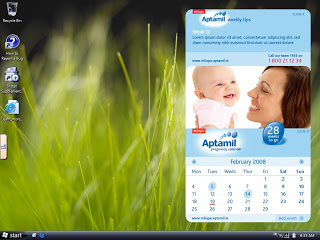
You’ll also be targeted in supermarkets, where Cow & Gate branded gifts such as dummies and growth charts are distributed. This photo was taken in Sainsbury’s, September 2007:
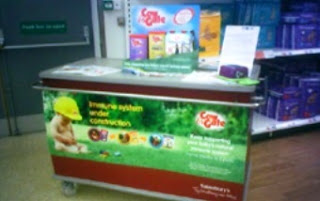
And here they are at it again in Tesco, August 2011:
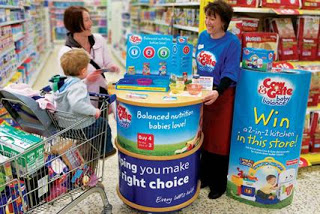
Aside from these examples, there’s also leaflets in health centres, email spam, snail-mail spam, supermarket ‘shelf talkers’ (plastic signs that flop out at you), pamphlets in Bounty packs, billboards, posters on public transport, internet pop-ups, TV commercials, radio advertisements, text messages, newspaper ads, social network advertising, YouTube video advertising, and several other gems I shall reveal bellow. Formula companies have an array of arsenal in their fight to line your baby’s gut, and more importantly, their pockets. The more cash they make, the more surplus funds they have to pump into their marketing arsenal. At this point you may wish to ponder what arsenal the breastfeeding movement has, and whose interests it serves.










